#OceanGate Expeditions submersible
Text
Titanic sub suffered 'catastrophic implosion,' all five aboard dead
By Joseph Ax and Steve Gorman
23 June 2023
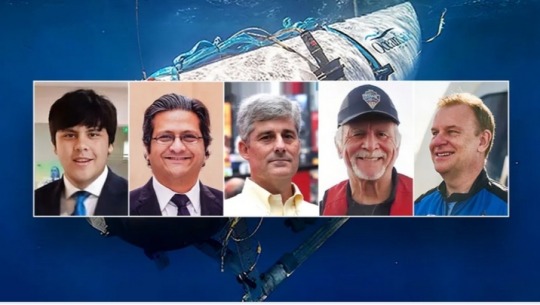
June 22 (Reuters) - The five people aboard a missing submersible died in a "catastrophic implosion," a U.S. Coast Guard official said on Thursday, bringing a grim end to the international search for the vessel that was lost during a deep-sea voyage to the wreck of the Titanic.
"These men were true explorers who shared a distinct spirit of adventure, and a deep passion for exploring and protecting the world's oceans," OceanGate Expeditions, the U.S.-based company that operated the Titan submersible, said in a statement.
"Our hearts are with these five souls and every member of their families during this tragic time."
An unmanned robot deployed from a Canadian ship discovered the wreckage of the Titan on Thursday morning about 1,600 feet (488 meters) from the bow of the century-old wreck, 2-1/2 miles (4 km) below the surface in a remote area of the North Atlantic, U.S. Coast Guard Rear Admiral John Mauger said at a press conference.
"The debris field here is consistent with a catastrophic implosion of the vehicle," Mauger said.
The five aboard included the British billionaire and explorer Hamish Harding, 58; Pakistani-born business magnate Shahzada Dawood, 48, and his 19-year-old son, Suleman, both British citizens; French oceanographer and Titanic expert Paul-Henri Nargeolet, 77, who had visited the wreck dozens of times; and Stockton Rush, the American founder and chief executive of OceanGate, who was piloting the submersible.
Rescue teams from several countries had spent days searching thousands of square miles of open seas with planes and ships for any sign of the 22-foot (6.7-meter) Titan.
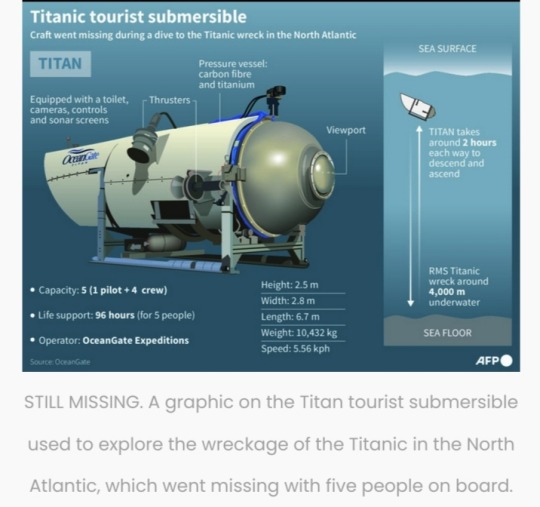
The submersible lost contact with its support ship on Sunday morning, June 18, about an hour and 45 minutes into what should have been a two-hour descent.
Mauger said it was too early to tell when the vessel's failure occurred.
The search operation had sonar buoys in the water for more than three days and had not detected any sort of loud explosive noise during the period, Mauger said.
The buoys had picked up some sounds on Tuesday and Wednesday that temporarily offered hope the people on board the Titan were alive and trying to communicate by banging on the hull.
But officials said analysis of the sound was inconclusive and that the noises might not have emanated from the Titan at all.
"There doesn't appear to be any relation between the noises and the location of the debris field on the sea floor," Mauger said on Thursday.

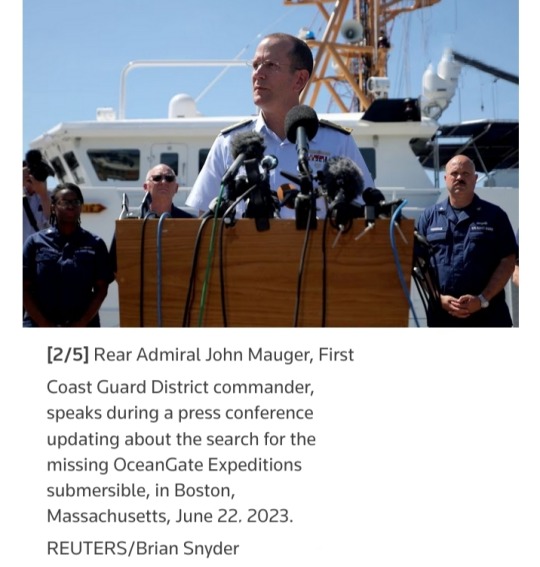
Robotic craft on the ocean floor will continue to gather evidence, Mauger said, but it is not clear whether recovering the bodies will be possible given the nature of the accident and the extreme conditions at those depths.
Five major pieces of the Titan have been found, including most of the pressure hull, officials said.
SAFETY CONCERNS
The search had grown increasingly desperate on Thursday, when the estimated 96-hour air supply was expected to run out if the Titan were still intact.
The Titanic, which sank in 1912 on its maiden voyage after hitting an iceberg, killing more than 1,500 people, lies about 900 miles (1,450 km) east of Cape Cod, Massachusetts, and 400 miles (640 km) south of St. John's, Newfoundland.
The expedition to the wreck, which OceanGate has been operating since 2021, cost $250,000 per person, according to OceanGate's website.
Questions about Titan's safety were raised in 2018 during a symposium of submersible industry experts and in a lawsuit by OceanGate's former head of marine operations, which was settled later that year.
The sweeping search covered more than 10,000 square miles of ocean - about the size of the U.S. state of Massachusetts.
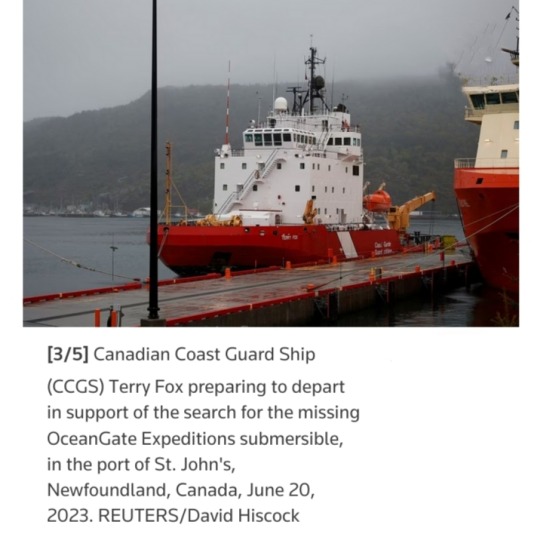
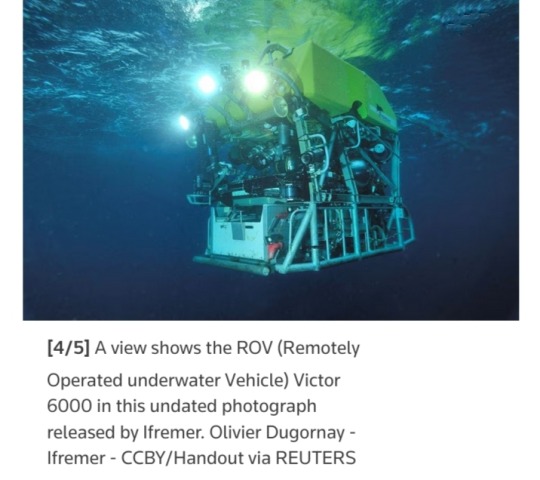

On Thursday, the deployment of two specialized deep-sea unmanned vehicles expanded the search to the ocean's depths, where immense pressure and pitch-black darkness complicated the mission.
The missing submersible and subsequent hunt captured worldwide attention, in part due to the mythology surrounding the Titanic.
The "unsinkable" British passenger liner has inspired both nonfiction and fiction accounts for a century, including the James Cameron blockbuster 1997 movie, which rekindled popular interest in the story.
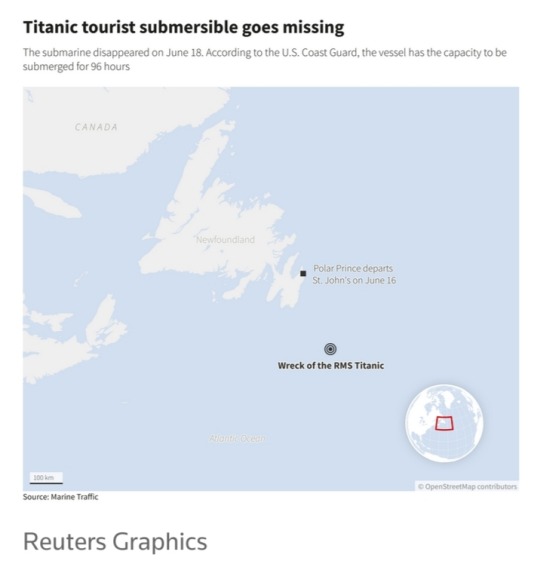
#OceanGate Expeditions#Titan submersible#catastrophic implosion#U.S. Coast Guard#U.S. Coast Guard Rear Admiral John Mauger#Titan#Titanic#Canadian Coast Guard Ship (CCGS) Terry Fox#OceanGate Expeditions submersible#Royal Canadian Air Force CP-140 Aurora#ROV#expedition#deep-sea voyage#wreckage
31 notes
·
View notes
Text
since i seem to be becoming a titanic guy, ive decided to just lean into it and explain the best i can, in laymans terms, what happened to titan and why the design had been criticised by experts in the deep-sea diving community.
i will preface this with the fact that im not an engineer. i have a psychology degree so this is not in my wheelhouse; im simply attempting to relay the information that has been made public in a more layman-friendly way. if i get anything wrong, please correct me.
a second preface is that quite a lot of this post is relying on oceanliner design’s video on this topic. though hes less critical of oceangate than i am, mike does a great job of breaking everything down so anyone can understand it. [any statements i make without listing a source are likely to be information from this video]
so with that out of the way, lets jump into it:
first, lets talk about what titan was. ive seen it described as a submarine by many people and im pretty sure ive also described it as such, but titan was a deep-sea submersible with a guiding philosophy of simplicity.
whats the difference between them?
submarines are self-independent vehicles meaning they do not rely on exterior support.
meanwhile, submersibles can submerge and can act independently to an extent, they primarily rely on exterior support such as being tethered to the mother-ship, or in titans case, receiving navigational inputs from said ship.
and here we meet our first bit of criticism; almost all other submersibles do not rely on external navigational inputs. they have their own equipment and systems for this. it may seem trivial, but as oceanographer peter girguis points out, these systems are as important for navigation as they are for the safety of the crew. [x]
when you are in water that deep, you need to know your exact position and be in constant contact with the mother ship. and its not as if oceangate did not have access to this technology, the beacons they use are commercially available. instead, they relied on short texts as a form of communication which is simply unacceptable. the submersible limiting factor has real-time verbal communication between those in the sub and those on the mother ship on dives 27,000 feet deeper than the titanic wreck.
“titan [did] not appear to have some of the other kinds of sensors, beacons and other systems that we use in research, that are also important just to maintain contact.”
“titan was not designed with research in mind.”
most deep-sea submersible designs are based around the design for the dsv alvin as it was one of the first of its kind. you might ask why its alvin that designs are based around and not another. well that would be because alvin was launched in 1964 and is still in use today and has completed over 5000 dives.
and this is why so many in the deep-sea submersible community are so outraged at titans design. titan was around 5 or 6 years old when it imploded; alvin is 59 this year. we have the technology to create submersibles like alvin or limiting factor that are arguably safer to be in than on the deck of a ship [x]; this disaster should never have fucking happened.
okay, so now lets move onto the actual design of titan which differs very much to most other deep-sea submersible and this is not a good thing. the reason most designs are so similar is because these features have been shown time and time again to be safe. again, ill refer to what peter girguis stated:

anyway, ill get back on topic. this is alvins design:
alvins pressure vessel is a large sphere with titanium walls that are 2 inches or 5cm thick. titanium is used as it is a very strong metal as whathisname from 2012 sang about, and a sphere is used because its the best shape for equally distributing pressure. when designing these vessels, you do not want any areas where pressure can build up and a sphere does not have any; the entire structure reinforces itself.
unlike literally every other deep-sea submersible, titans pressure vessel was not a sphere and not made of titanium, rather it was cylindrical with two hemisphere on either side and was built out of carbon fiber. see the shape below:
the important part is the big circle labelled “personal sphere”. this is called the pressure vessel and is where crew and any equipment needing protection from the water pressure reside. this vessel needs to be able to withstand around 6000 pounds or 3 tonnes of pressure per square inch, which is about 400 times the pressure on the surface.

if they had followed previous designs, they would have had to make a much larger sphere in order to fit everyone. but the bigger you make your sphere, the weaker it becomes so you then have to use thicker walls, and all of this makes the pressure vessel much heavier. and this is where youd run into problems because the submersible still needs to be able to plucked from the ocean at the end of the trip and to power itself in the water. the heavier it is, the harder this becomes.
first, well address the shape. as the design philosophy of titan was so that it could carry up to 6 passengers, it would have been very difficult for the pressure vessel to be shaped as a sphere. alvin, in comparison, can only fit three crew and equipment.
so instead, they chose a cylinder. this is not a terrible choice by itself. it is preferable to use round shapes in high-pressure environments as pressure builds up in corners, especially right angles. if youve ever wondered why plane windows have round corners, its because the square windows on the de havilland comet (the worlds first jetliner) gave areas where pressure could build up and caused the jet to suffer a series of explosive decompressions. it crashed many times. [x]
now, well get into where the design really has problems: the materials used. as i mentioned, the majority of the pressure vessel was made of carbon fiber. the ceo of oceangate, stockton rush, believed that carbon fiber would have a better strength-to-buoyancy ratio than titanium, and this was one reason why it was chosen. [x]
so in terms of shape, its not the worst choice. it is much preferable to use a sphere as a cylinder is not as adept at equally distributing pressure, but their choice was at least logical.
on the end of the cylinder, there were two titanium rings bonded to the carbon fiber hull (though the method of bonding is not publicly available), and these rings were then bolted to two titanium hemispheres. now, you might notice that titan does have four right angles in the pressure vessels, but these are within the vessel so as long as no pressure can get into vessel, these are fine.
the problem with this is that carbon fiber is an experimental material that has not been fully evaluated. stockton rush was very aware of this as he was repeatedly warned by many experts in the field, including deep-sea exploration specialist rob mccallum who stated that:
“that carbon fibre is not an acceptable material”
if this occurs, not only do the gaps give areas for pressure to build, the pressure vessel becomes much weaker, and runs the risk of failing as happened. this risk only gets worse when you decide to use expired carbon fiber.
now, you might be saying “kai, you literally told us earlier that they did use titanium” and if you are, A+ to you my friend, youve led us straight onto another problem with the design of the titan: using multiple materials.
one major concern about the carbon fiber for the hull is that it had to be layered up and cured in between until the hull was 12.7cm or 7 inches thick. these layers cause a problem that titanium does not have; there is a risk of de-lamination, aka the layers separating. as previously stated, the titan was several years old so it had already gone through many pressurisations and dive cycles which all run the risk of de-laminating the hull.
and this, ladies and gentleman and those of us past that stage, is why deep-sea submersibles use titanium not carbon fiber.
by designing titan like this, stockton rush strayed ridiculously far away from any other designs which have been tested and shown to work. the submersible was not safe to travel on, especially so far down to be able to visit the titanic wreck. as rob mccallum states:
you just dont do it. by introducing areas where multiple materials meet, you are introducing potential points of failure because well done, stockton, youve introduced yet another area where pressure can build up.
“[titan] was the only submersible in the world doing commercial work that was unclassed. it was not certified by an independent agency.”
in fact, it makes sense to go through the process because you then know that your vessel is safe and idk, its probably better for marketing if your vessel has been certified as safe.
mccallum goes on to describe stockton as a “maverick entrepreneur” who wanted to think outside of the box even when it comes to things like the rules of physics or tried and true engineering principles.
and im sure we can all guess why. it wouldnt have passed and the company has recognised that the design lays outside of the accepted system. though its not a mandatory process even though it really fucking should be, theres no reason to not let your vessels be examined by a marine organisation.
we know that the hull was breached. we know this as one of the very few safety features aboard titan was something known as a “real-time hull health monitoring system” or an rtm. [x]
and he is completely right because what happened to the titan showed how the design of it was so flawed. [x]
“if you steer away from sound engineering principles, which are all based on hard won experience, there is a price to pay, and its a terrible price”
this did what it said on the tin and it did before the catastrophic implosion of titan. when the rtm picked up on too much strain on the hull, it sounded an alarm as a warning. those on board were prepped so they knew what this meant so they used one of the other few safety features on the sub: dropping the ballasts.
ballasts are heavy material gathered in the bottom of a ship or vessel to help stabilise the ship. you use them in order to stop a ship from becoming top-heavy as a top-heavy ship is much more likely to capsize; see the ss principessa jolanda that sank at launch as she launched with all her fittings completed and empty ballasts, causing the center of gravity to be too high. some ships have port and starboard (left and right) water ballasts and if theyre listing dangerously to one side, they can release the water in that ballast to attempt to stabilise the ship.
this, again, is an area of criticism as most submersibles have multiple features that can be used in an emergency. marine geologist, chris goldfinger points out that most submersibles have multiple ways of self-rescue, such as detaching the pressure vessel from the sub itself. [x]
in the case of the titan, dropping the ballasts was the only way the ship could surface in an emergency. it appears that those on board attempted to do so, but did not surface quick enough to avoid catastrophe.
“[titan did not have] nearly that much redundancy and self-rescue capability."
“im concerned that they [oceangate] overlooked some of the features that we build into research submersibles, because they struck [the builders] as costly or unnecessary, or uninteresting. a lot of those features that we see across submersibles have evolved over decades, precisely because they work, and because we know it increases safety for the crew.”
"i have grown tired of industry players who try to use a safety argument to stop innovation"
hes also stated that titan was underprepared which most experts in the field agree with, such as girguis who stated that:
and we know that stockton rush was aware of all these issues; email exchanges show that people at the company came to him with concerns, but he brushed them away. instead, we have statements from him like:
he heard warnings from employees and from deep-sea submersible experts, and a former employee david lochridge alleged in a counterclaim lawsuit in 2018 that he was fired for raising concerns over quality control and testing of potential flaws. [x]
keep in mind that oceangate originally sued him for breach of contract because he brought all of his concerns to osha because he was that concerned. though, this was settled out of court, it clearly shows that this disaster was years in the making.
“it was only a matter of time before they killed somebody.”
as victor vescovo stated:
#titan#titan sub#titan submersible#oceangate#titanic#titanic wreck#oceangate expeditions#long post#stockton rush#titan disaster#deep sea#deep sea submersibles#oceanliner designs#victor vescovo#david lochridge#osha#rob mccallum#ss principessa jolanda#dsv alvin#de havilland comet#peter girguis#limiting factor#caladan oceanics#chris goldfinger#james cameron#tw death#kai rambles#shipposting
41 notes
·
View notes
Text
Legal Eagle posted a video this morning about OceanGate and I'm having complicated feelings that Stockton Rush himself won't have any direct legal smackdowns happen to him because well... he imploded in the Atlantic.
On the one hand, his hubris already got him.
On the other hand, legal smackdowns.
13 notes
·
View notes
Text
17 notes
·
View notes
Text
What we know about the missing Sub
For whatever reason this story has absolutely grabbed my attention, and so I will be compiling the information that I can confirm in a decent timeline of events, feel free to message me if y'all feel like something needs to be changed/revised
A company known as OceanGate offers dives to view the wreck of the Titanic, charging 250,000 USD per ride. This sub is not approved by any regulatory body, and is controlled with an xbox controller. The inside is a small tube one would have to sit down to fit inside.
It is not a regular sub, but a submersible, which does not have the power to lauch itself and return on it's own, but instead must be launched and retrieved by a mothership. Thus, constant communication is of the utmost importance.
4 AM, June 18th, an expedition begins. Confirmed passengers are a pilot, a "Content Expert," Businessman Hamish Harding (who posted the linked instragram post,) and two other passengers who are as yet unconfirmed.
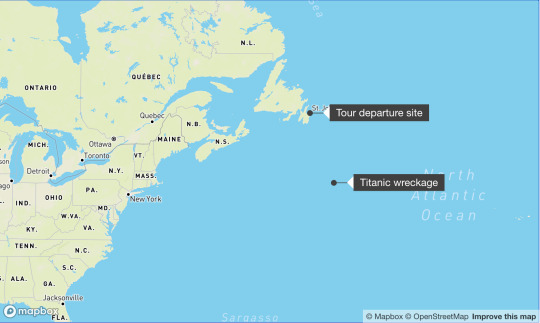
Communications with the sub are lost 1 hour and 45 minutes into the dive.
The US and Canadian coast guard begin working together to try and find the sub. The vessel has an advertised 96 hours of oxygen.
The instagram post earlier is found by CNN, although they do not yet divulge who posted it. They reach out to OceanGate for comment and get none.
An additional vessel is dispatched to assist in the search.
The US Coast Guard holds a press conference where they discuss the difficulties in locating the vessel in the remote area it dove into.
Coast Guard surmises that there is 70 to 96 hours of oxygen remaining, although this was reported abt ten hours ago, so it's more like 60 to 86 now.
The coast guard also begins a twitter thread which they are continually updating. They have completed two flights over the area but have not found anything, they will dispatch another plane in the morning.
OceanGate claims to be taking "every step possible" to recover the missing vessel.
Twitter user Kenny Sharpe realizes that he had seen the vessel being towed out to it's expedition and posts photos that he took.

LITERALLY FOUND THIS AS I WAS GETTING SOURCES, Daily Mail claims that the other two passengers are businessman Shahzada Dawood and his son, but given DM's dubious journalistic integrity (to put it nicely,) I would take this claim with a grain of salt until other sources confirm it.
I will update this as more info becomes available, feel free to message me with sources if you know anything.
18K notes
·
View notes
Text
If someone told me that a submersible named the Titan, owned by a company called OceanGATE, carrying three billionaires, had gone missing on an expedition to the Titanic, I would think it was some pitch for a new thriller mystery novel and not something that had actually happened due to the hubris and stupidity of rich people.
#titanic#titan#oceangate#original post#not incorrect quotes#lol#submarine#the titanic#the titan#current events#james cameron
15K notes
·
View notes
Text
Wreckage of 'Titan' submersible brought to surface
Five people were killed when the tourist submersible imploded while diving toward the Titanic.
The wreckage of the Titan submersible was seen on shore Wednesday, ten days after the craft suffered a catastrophic implosion, killing all five people aboard.
Multiple large pieces of the submersible were lifted by crane from the recovery ship which carried them back to dry land in Canada. The pieces…

View On WordPress
0 notes
Text
Not crazy about people writing off the Titan submersible incident as some schadenfreudic buzzstory they can rag on for a handful of internet funny points. I get the frustration, I really do. At least three of the passengers had to shell out $250,000 a ticket for a glorified deep sea Disney ride. The CEO of OceanGate is a capitalist wackjob who has been complaining about and bypassing safety regulations for years, despite multiple warnings, and now the retrieval is taking up time and resources from multiple countries that could have been put to better use. But one of the crew members on board was also the nineteen year old son of another passenger. I doubt his involvement extended much beyond “I’m going on a fun trip with my dad.” Another was an unaffiliated researcher who joined the expedition to collect environmental samples for DNA analysis. Not everyone on board was a high-rolling corporate yuppie. (And even if they were, it’s still a pretty objectively horrific way to die.) Instead of memes, I’d rather see this prompt a discussion on the ethics and potential regulation of scientific tourism.
The above also doesn’t change the fact that this is dragging media attention away from more pressing issues, such as the sinking of the Andriana. I guess “THE TITANIC CLAIMS ANOTHER FIVE VICTIMS” is a more colorful headline than “the EU’s xenophobic migration policies have led to the deaths of hundreds of migrants seeking asylum in Italy, and an active cover up is now taking place, headed by Greek authorities.” Seeing all this energy be funneled towards dragging this tiny capsule out of the Atlantic when up to five hundred refugees - mostly women and children - were locked in the hull of a ship and left to suffer the exact same fate, while Coast Guard vessels looked on and did nothing (or even had an active role in the capsize after a botched attempt to tow it, according to some testimonies), illustrates the sway money and race have in what we pay attention to. It’s a gruesome example of inequity in action.
I had compared what happened to the Titan to the Kursk incident, but the Andriana doesn’t have the luxury of being a freak accident. Over 25,000 migrants have disappeared or drowned trying to cross the Mediterranean since 2014, with over 2,000 deaths taking place in 2022 alone. Those are staggering numbers. Protests have broken out across Greece over the past week in the wake of the tragedy, advocating for migration reform.
While these sorts of mass casualty events tend to leave us feeling disheartened and helpless, there are ways to help. Below is a link to SOS Humanity’s donation page. Reputable search and rescue organizations such as SOS Humanity or SOS Mediterranée built their mission statements around helping migrants like the ones on board the Andriana. Donate if you can, spread the word if you can’t.
3K notes
·
View notes
Text
American financier Jay Bloom offered 'last minute' discounted price to sit in doomed Titan submersible with his son - but he turned it down over safety concerns
An American tycoon has revealed a text exchange with submersible chief executive Stockton Rush, who tried to convince he and his young son to pay for a reduced six-figure seat to see the Titanic by telling him: "It was safer than crossing the street."
By David Wu
June 24, 2023

An American tycoon has revealed how submersible chief executive Stockton Rush tried to convince he and his son to buy two tickets on the doomed Titan vessel.
Financier Jay Bloom shared the text exchange with Mr Rush months before the CEO died with four other passengers when the craft suffered a "catastrophic implosion."
He tried to offer his friend a "last minute price" of $AUD225,000, with the original cost of the seat valued about $365,000 in April for an expedition the following month.

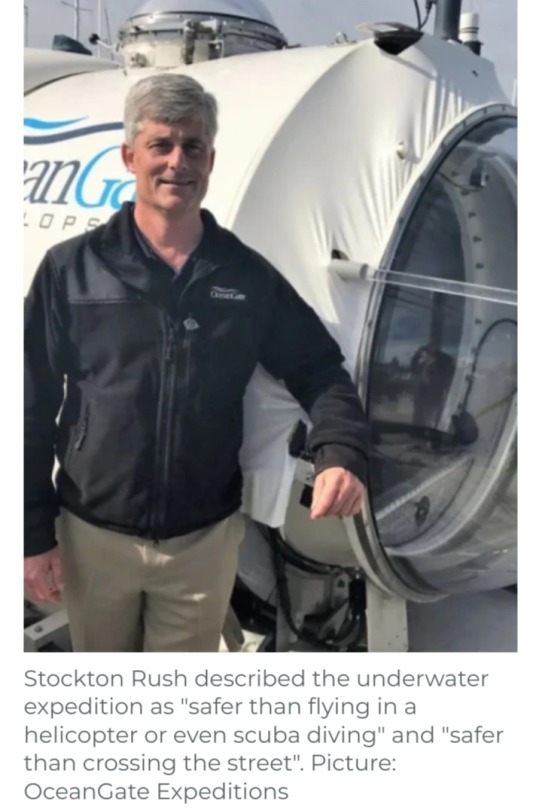
The first messages started as far back as February, when the chief executive wondered if there was an interest to see the famous shipwreck in the Atlantic Ocean.
Mr Bloom said his son Sean had been "put a little scare in him" after one of his friends researched the dangers of travelling in deep waters.
"I'm happy to have a video call with him. Curious what the uninformed would say the danger is and whether it's real or imagined," Mr Rush responded.
The financier said his son was worried about "perceived threats to the vessel," such as a sperm whale or a giant squid attack compromising Titan's hull.
"Yeah, very stupid. The pressure is over 100 million pounds. No sperm whale or squid is ever going to be able to mess with the sub," Mr Rush replied.
"While there's obviously risk, it's way safer than flying in a helicopter or even scuba diving. There hasn't been even an injury in 35 years in a non-military subs."

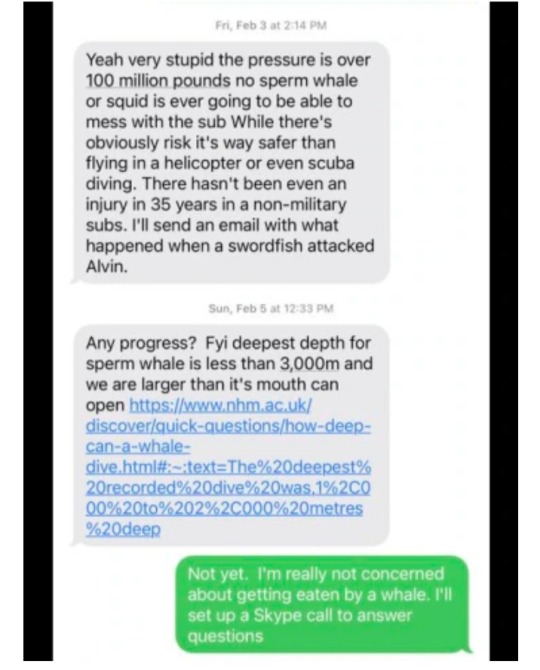
Three days later, Mr Rush would again try to reassure Mr Bloom and his son by sending a link to how deep sperm whales can go underwater.
Mr Bloom said he was not concerned about being eaten by a whale and decided to set up a Skype call, so his questions could be answered properly.
There would be limited text communication before Mr Rush sent a message on April 24, offering discounted tickets to see the Titanic wreck.
"Have a space on mission 1 (may 11-19) and 2 (may 20-28). Last minute price is $150k pp," the chief executive advised.
Mr Bloom said he would have to check his schedule to see if he could fit it in, as Mr Rush asked three days later: "Any luck?"
That trip would be later postponed to June 18 due to weather conditions.
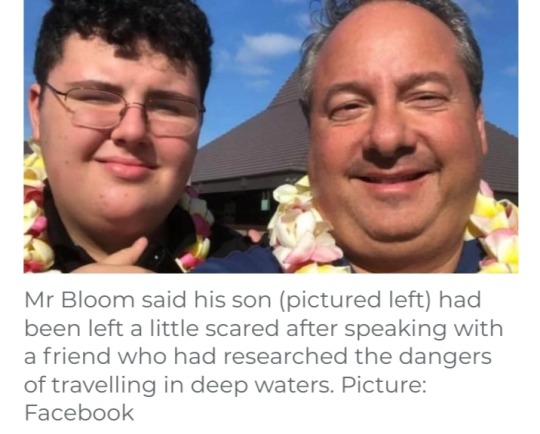


Mr Bloom shared the messages to his Facebook page.
The financier even met face-to-face on March 1 with Mr Rush, who took him through the Titanic Exhibit at Luxor in Las Vegas before having lunch at a food court.
"He was absolutely convinced it was safer than crossing the street," Mr Bloom said on the post about his interactions with the creator of Titan.
Mr Rush also gave him a limited edition of a book of photos signed by him and French mariner Paul-Henri Nargeolet, 77, who was also aboard the submersible.
Mr Bloom advised he could not join them on the once-in-a-lifetime trip until 2024.
Their tickets were later sold to prominent Pakistani businessman Shahzada Dawood and his 19-year-old son Suleman, the latter who was "terrified" to go.
The fifth person was adventurer and British billionaire Hamish Harding.
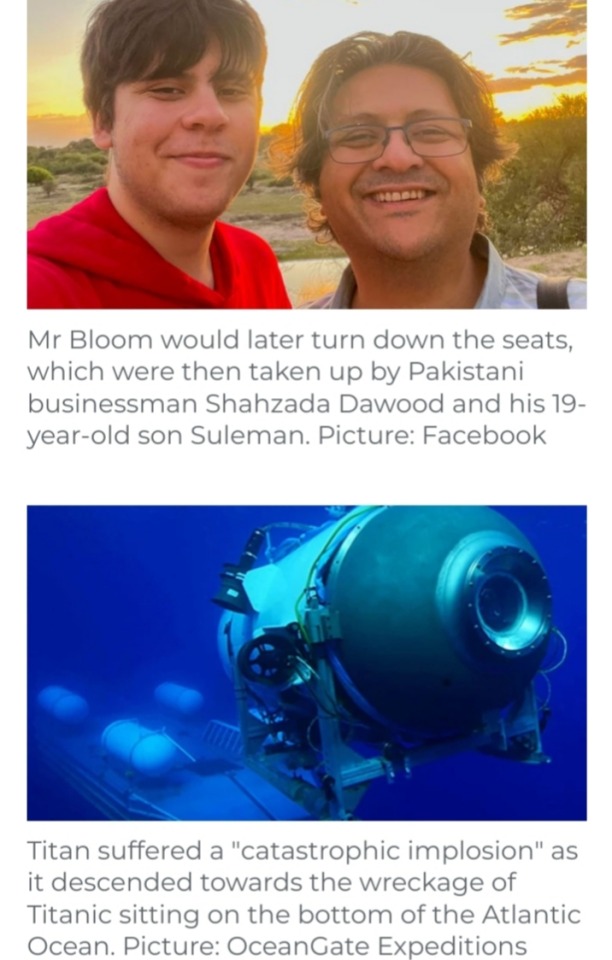
The five men entered Titan and started their 3,800m journey down to the bottom of the Atlantic Ocean on Sunday morning.
However, less than two hours into the trip, mothership Polar Prince lost contact with the roughly six-metre long vessel, which sparked a large-scale international search.
The United States Coast Guard on Thursday (local time) confirmed pieces of debris found near the Titanic wreck belonged to the missing submersible.
"An ROV subsequently found additional debris, in consultation with experts from within the unified command, the debris is consistent with the catastrophic loss of the pressure chamber (of Titan)," Coast Guard Rear Admiral John Mauger told reporters.
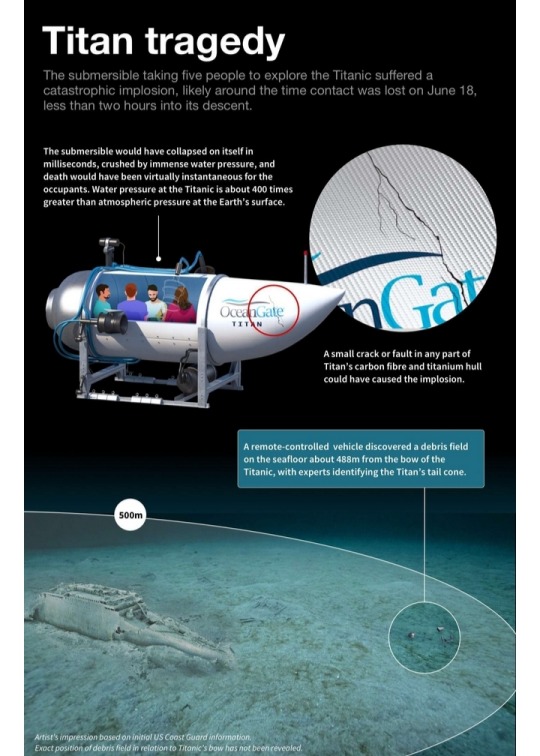
Undersea expert Paul Hanken said five major different pieces of debris had led experts to conclude they were the remains of the OceanGate Expeditions craft.
"The initial thing we found was a nose cone, which was outside of the (Titan) pressure hull. We then found a large debris field and within that large debris field we found the front and back of the pressure hull," he said to reporters.
"Shortly thereafter, we found a second, smaller debris field and within that debris field we found the other end of the pressure hull.
"(It) ultimately contained the totality of that pressure vehicle. That was our first indication that there was a catastrophic event."
It was revealed the US Navy had detected an "anomaly consistent with implosion or explosion" where Titan was reported missing hours after the sub departed.
The Transportation Safety Board (TSB) of Canada announced on Friday (local time) it has launched an investigation, as Polar Prince was a Canadian-flagged ship.
A team of investigators will travel to St Johns in Canada's Newfoundland and Labrador where they will "gather information and conduct interviews."
It will also coordinate its operation with other agencies.
TSB will provide updates throughout the investigation.
#Titan submersible#Titan#Titanic#catastrophic implosion#Stockton Rush#Jay Bloom#OceanGate Expeditions#Titanic wreck#Polar Prince#United States Coast Guard#Coast Guard Rear Admiral John Mauger#US Navy#Transportation Safety Board (TSB) of Canada#Paul-Henri Nargeolet#Shahzada Dawood#Suleman Dawood#Hamish Harding#Paul Hanken#St Johns#Canada#North Atlantic#Titanic tourist submersible
49 notes
·
View notes
Text
This is About Oceangate
...kind of. Like, heads up for people who are sick of hearing about it or are too disturbed by this, just scoot on by, that's fine.
Like everybody else my age who had a middle school special interest in the Titanic that was further fueled by the James Cameron movie (and that sounds very specific, but I absolutely know I'm not alone), I've been following this story fuckin voraciously.
I think everybody I know IRL and online is fucking sick of me talking about it. I have been actively trying not to blog much about it here because I'm so obsessed with it that I'm annoyed with myself. I would like to not be this interested in it.
But a lot of the stuff I can think of to say has been said by a lot of people already, I don't want to add to an already noisy environment if I've got nothing new to say.
So, instead, I want to talk about what I haven't seen very many people talking about- something that's stood out to me about the way the media has been handling this story from the get-go. So, finally, I'm inflicting my days long media binge on you.
The media's handling of this was bad. Like, comprehensively fucked.
For the uninformed, a primer on the situation- feel free to skip down if you know all this, there's a bulleted list right after I get done with this part, look for that. But some of this is important to the terms I use, so I wanted to lay it out. (Also I just want to get a lot of this out of my system, please just let me have this.)
The Titan is a 'cyclops-class' submersible. As far as I can tell, 'cyclops-class' is unique to the people who made this submersible, it's not a widely recognized thing.
The Titan can carry up to five passengers. It was supposed to be rated to reach depths of up to 4000 meters below sea level.
The Titan is/was owned and operated by a company known as Oceangate. There's a lot of questions regarding the safety of the submersible, where the math came from on their depth rating, and- basically everything about the Titan is in question, at this point. There's a lot of questions, but that's not what I want to talk about.
Right now. Maybe later.
A submersible is distinct from a submarine in that it requires a surface support ship for many things- the Titan moved too slow to leave port under its own power and go to the site, it didn't have enough life support to do that kind of thing, etc. A submarine is self-supporting and can operate independently. Kind of pedantic, I know, but the Titan is a submersible, not a submarine.
The Titan had a planned expedition to the wreck of the Titanic on June 18, 2023- this past Sunday, at the time of writing. The expedition was supposed to last around 10 hours. It chartered a ship- the Polar Prince- to act as mother ship, the on the surface support that the Titan requires. (The Polar Prince is owned and operated by a different company than the Titan.)
1 hour and 45 minutes into the expedition, as the Titan was still making its way to the sea floor, the Polar Prince lost all contact with the submersible.
The Titanic wreck is at just under 4000 meters deep, right around 2.5 miles.
Now, my understanding is that the Titan was not fully at the ocean floor at the point contact was lost, but it's not clear how deep the Titan was at that time. We may not ever know this for certain.
When the Titan was reported as missing to the coast guard is kind of unclear, to me- I heard 6 hours after they lost contact, I heard 12 hours after they lost contact, I saw something that indicated they reported it missing immediately- I don't know for sure. When the coast guard report comes out, I'm hoping we'll get a more accurate timeline.
However, as soon as it was reported missing, a massive search and rescue operationg was started. Complicating the search efforts were the fact that the submersible seemed to have no type of emergency distress locator beacon (I'm not sure what the precise nautical terminology would be for this).
The search included visual searching of the surface, dropping buoys with microphones, and ROVs (unmanned remote operated vehicles, deep sea robots operated by crew on ships at the surface) searching the floor, and probably some other stuff I'm forgetting. Deep sea radar etc etc, every tool they had access to.
The search and rescue concluded on Thursday (June 22, 2023) around midday, when they definitively found pieces of the destroyed submersible's pressure vessel (the part of the submersible that held pressure and kept the people safe and alive) in a debris field, approximately 1600 feet away from the Titanic.
The destroyed pressure vessel and reports from the Navy on hearing sounds consistent with implosion at the time the Titan lost contact indicates that the submersible underwent what is being called a 'catastrophic implosion'.
It is now an investigation and recovery operation, while they try to figure out what exactly went wrong.
The five men in the sub are dead. In all likelihood, they died so quickly that their nervous system didn't have time to process what happened. What happened to their bodies during this was probably gory and kind of horrifying, but it's unlikely they experienced any awareness of this.
There were five extremely wealthy men on the submersible- they were not all billionaires, but those that weren't were worth hundreds of millions of dollars. If you want a rough sketch of their biographies, there's a link here. Other than them being pretty wealthy, who they are doesn't play that much into what I want to talk about, so I don't feel the need to go into it right now. (Again, as more information comes out, I may come back for another swing.)
So, my complaint. The number of times I saw a news interview with an expert that went like this is not small:
news host interviews deep ocean expert of some variety (who is not involved in rescue)
host asks expert what chances are that the dudes are alive and will be recovered alive
expert, being honest, says something like 'slim to none'
host responds with some amount of sincere-seeming disappointment, then after interview, pivots to the ongoing search for the definitely still alive people
There were news programs with clocks counting down how much theoretical oxygen was left. There were frequent updates to news stories with nothingburgers of additions, just to pad it out. It was, if they were alive at that moment, fucking ghoulish. That they were dead makes it even more horrible.
And I cannot emphasize enough how many experts said, to generalize and paraphrase here: "Unless they are found bobbing on the surface in the next n hours, they are dead. Even if they are alive right this minute, on the bottom of the ocean, there is no hope to rescue them in time."
This is not a failure of any of the rescue entities involved, by the way. The environment they were presumed to be in- 4000 meters under sea level- is so extreme that there are very few vehicles in the world with the capability of even getting to that depth. Like, 10 or less. As far as I know, none of them are designed to do any kind of deep sea rescue- which would have involved carefully scooping up or netting the Titan and hauling it up very slowly. There's no way to transfer personnel between ships at this depth, and the Titan had the largest passenger allowance at this depth, afaik. Like, the odds were incredibly, vanishingly small that these men would live.
The media, at large, never ever really allowed that to change the way they talked about this story or treated the participants in the story. At around 11 am or noon (central daylight time) on Thursday I saw them talking about how 'oxygen is critical'.
Oxygen was critical 24 hours prior. Even by the most generous of expectations, they were out of breathable air. Given how, to put it mildly, janky the submersible seemed to have been, there was absolutely no guarantee that they had even the 96 hours that Oceangate claimed.
Their likelihood of being rescued alive from the ocean floor was minimal on Monday. By Thursday, they were dead- again, unless they were found on the surface somewhere and had managed to carefully preserve their air somehow, they were already dead.
The media didn't really allow for the reality of the situation to be clear until Oceangate and the USCG came out and said 'yeah, they're dead'.
"Well, what's the problem with that?" you might ask. "The United States Coast Guard was the one who was saying it was a rescue up until that point."
Sure. That's their job. Their job is to treat it like an urgent rescue until it is certain that it is not. A significant amount of what they do is to rescue people from doing damnfool things in the water, and keeping hope alive until they find bodies, or evidence thereof. They were doing exactly what they should be doing.
(Whether they do this to this extent for everybody lost at sea is another conversation that's absolutely worth having, as well as their role in border patrol, but I have no bone to pick with the USCG in this particular instance. They did their all until they could do no more, that's the whole point of them, this is how they're supposed to operate.)
The media was not doing what they should be doing. There's an old quote somewhere that I think is just a journalism truism (everyone I've heard talk about it says their journalism professor said it)- if someone tells you it's raining, and someone else tells you it's not, your job isn't to report that, your job is to go outside and see if it's wet.
James Cameron- director of the aforementioned Titanic movie, as well as being a Titanic and deep sea submersible expert, knew they were dead on Monday.
He reached out to some people, he found out that the mother ship lost contact with the crew as well as their location at the same instant, and that the Navy heard a sound consistent with an implosion at around that time.
The information that the Navy heard the implosion was not classified information- they heard it via a listening system that was declassified in the 90s, I believe. Like, I knew about the system just kind of casually because I know random Navy stuff. (My dad was in the Navy, it's mostly osmosis.)
The people on the scene were informed as soon as the Navy knew. (When that was, I'm not sure, except it was before Monday. Probably they had someone go back and listen to it and weren't actively monitoring it, but it's hard to say.)
The deep ocean submersible community knew, well enough that James Cameron could call a buddy and find out. He was telling people on Monday to raise a glass to them.
The media could have had this information, if they did not have it. Either they didn't want to know, or did know, and didn't say it. And I can't say for certain they were suppressing information, but I do know that they frequently downplayed any evidence that these people were dead.
I know on CNN they ran a story about FADOSS- the FlyAway Deep Ocean Salvage System- that was shipped out to Newfoundland. It arrived Wednesday afternoon. Description in the alt text, link here.
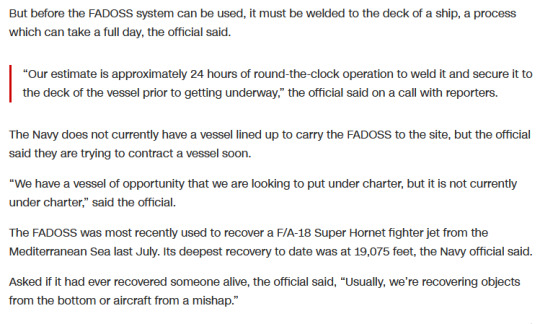
At the time this story was published, the people in the sub would have theoretically had less than 24 hours of breathable air. They hadn't even chartered a ship for the FADOSS, at this point. And the port in Newfoundland is hundreds of miles from the site. I'm not sure how many hours away but, like, hours away. I think I heard it's a 6 hour trip, but I'm not certain on that.
This system was referenced in the news as if it was going to be part of the rescue process. Very clearly, this was never going to happen. The quote, 'a process which can take a full day' is a mild understatement, here.
It could, theoretically, be done in 24 hours, but was much more likely to take longer, unless they had enough crew in Newfoundland to do round-the-clock welding.
The response to the question about recovering someone alive is a polite way of saying 'that's not what we do'. They were not part of the rescue operation and were never intended to be, as far as I can tell.
(If you're wondering what part the FADOSS is going to take in the recovery and investigation process, it's not. It's used to lift heavy objects off the floor, and the Titan broke into small enough pieces that the ROVs are believed capable of handling it. FADOSS is on its way back to wherever it is kept. I suspect it was brought out in the edge case that the submersible was found intact with dead crew, to retrieve the vessel whole, so that the families would have bodies to bury.)
Setting aside the 'oh they definitely blew up' news that seems to have been available the whole time, every single piece of evidence and expertise pointed to these people being dead, and yet the news persisted in sort of breathlessly (sorry) talking about the rescue efforts and how much time was left. They persisted in talking about how definitely still alive these people were until they could not do that anymore.
Other examples of this issue are the knocking thing. There were reports of some of the buoys picking up something that could be described as 'knocking'. Some said it was 'every thirty minutes' but we don't know how precise a measurement that was. As soon as they started talking about the knocking, I looked into it.
As it turns out, this is just a thing that happens. The sea is very noisy, and it's hard to determine the source of a sound. Some geological things sound manmade, vice versa. They had a lot of ships cooperating together to work the search area, it's possible that they were hearing noise from those, or something from an oil platform a jillion miles away, because noise travels far and is hard to pinpoint. They had this issue while searching for the sunken USS Thresher and it was one of the ships doing the searching. Given how many different moving parts there were in this search operation, it's hard to say what the knocking was. This is just a thing in the ocean, there's a lot of fuckin noise and experts can't always pinpoint it down in location or even what it might be.
This is why, even though they heard sounds that were consistent with implosion, at the time that the Titan lost total contact with the mother ship, it was still treated as if there was a live rescue operation. Because they couldn't be certain.
But the odds were extremely poor that these men were alive, and almost everybody involved knew that fairly early on. Again, the rescue operation had to go forward like they were looking for someone alive because that's how that works. The media, on the other hand, handled this in a very irresponsible way.
And, like, I know, news media is bad at being news is not some like hot new thing, I've just been building up frustration for days and so it had to come out somehow.
I'm not sure how much of this was just because they're very wealthy men- only one of whom I've ever heard of before- and how much of it was because it was a very bizarre and unique ongoing situation, how much of it was the intersection of that.
But pretty much everybody with enough knowledge to be worth talking to about this knew, like, Monday that even if they weren't dead right then, they were very unlikely to make it out alive, and watching the news wind a bunch of people up over the hopeful outcome was revolting.
Okay. We'll see if I can go 24 hours without talking about this. If you made it to the end of this absolute fucking novel, congratulations and/or I'm sorry.
555 notes
·
View notes
Text
so one of the things that really bothers me about the titan (beyond the egregious disregard for safety) is how poorly it was fucking designed, and how because of its failure people are rethinking the safety of deep water submersibles in general.
like, let’s be clear: this has never happened before. nobody has ever died trying to reach the titanic. this kind of failure is completely unheard of. afaik nobody has died in a deep water submersible like this, ever.
i’m worried this is going to impact the funding oceanographic institutes receive for these kinds of expeditions using safe, accredited submarines.
thanks, oceangate.
451 notes
·
View notes
Text
Great story.
Stockton Rush was a bad person that basically committed unintentional murder/suicide.
#oceangate#titanic#twitter#stockton rush#the new yorker#Ocean#marine#Marine life#sea creatures#democrats#republicans
235 notes
·
View notes
Note
there was a teenager aboard the oceangate submersible. do you think he deserved to die?? it's not his fault his dad was a fuckwad billionaire
Did he deserve to die? No absolutely not. None of them deserve to die. Especially in such a tragic and horrific way.
HOWEVER
Should I find some poetic justice in a bunch of arrogant dumbasses hoarding wealth and actively killing people and our planet daily by going to tour a mass grave of working class people for funsies in a DIY sub that had many MANY warning signs that there was the chance it may implode because the guy heading the expedition ignored safety precautions because millionares and billionaires are known to constantly cut corners to "save money" even though they have so much of it they could have funded making a proper vessel instead of picking the cheapest route and ended up suffering the consequences of being so exuberantly wealthy they just assumed they were above any and all laws of nature?

#how's the boot taste anon?#i work for wealthy people ya'll have no idea how shitty they are#ask#I'm allowed to have multiple complex feelings about a serious situation and find morbid humor due to my personal life perspective#while still retaining my basic level of human emapthay#I feel so bad for the teenager and French explorer the most with the info I've read#but 3 other clowns still walked into that clown car#and that parent is responsible for the death of his child#should have known better to put his child in a dangerous situation#period
175 notes
·
View notes
Text
Azmeh Dawood — the older sister of Pakistani businessman Shahzada Dawood — told NBC News that her nephew, Suleman, informed a relative that he "wasn't very up for it" and felt "terrified" about the trip to explore the wreckage of the Titanic.
But the 19-year-old ended up going aboard OceanGate's 22-foot submersible because the trip fell over Father's Day weekend and he was eager to please his dad, who was passionate about the lore of the Titanic, according to Azmeh.
136 notes
·
View notes
Text
The Submersible Titan
OceanGate CEO Stockton Rush gives a tour of his submersible Titan.
He was one of five people that died on his own invulnerable submersible 'Titan'.
The submersible was carrying an expedition of tourists, including Hamish Harding, Paul-Henri Nargeolet, Shahzada Dawood, Dawood's son, Suleman, and the founder of OceanGate, Stockton Rush.
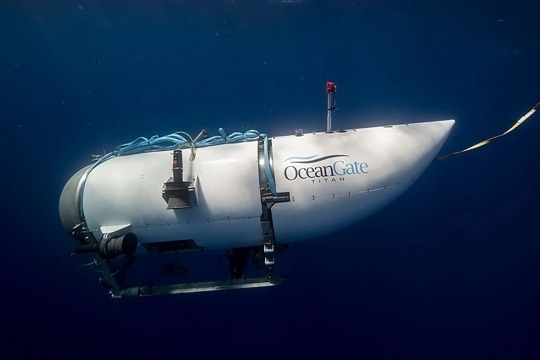


Debbie Field of Missing Submersible Titan Found Near Titanic
Debris has been found in the search for the missing Titan, including parts of its outside cover.
Dive expert David Mearns said the president of the Explorers Club - which is connected to the diving and rescue community - says the debris includes "a landing frame and a rear cover from the submersible".
The US Coast Guard earlier confirmed a "debris field" had been found within the search area.
It was located by a remote-controlled underwater search vehicle (ROV) near the wreck of the Titanic.
Some experts have speculated that it could have suffered a catastrophic implosion as a result of a hull failure. The minivan-sized submersible was owned and operated by the private company OceanGate Expeditions.
The firm's co-founder, Guillermo Söhnlein, said that he believes there may have been an "instantaneous implosion" of the craft.
"If that's what happened, that's what would have happened four days ago," he said.
#The Submersible Titan#Missing Submersible Titan Found Near Titanic#Titanic#Titan#OceanGate#submarine#submersible#titan submersible#stockton rush#shipwreck#implode#implosion#destroyed
126 notes
·
View notes
Text
Unfortunately, June 18, 2023, wasn’t the first time I’d heard of Rush, or his company OceanGate, or his monstrosity of a sub. He and the Titan had been a topic of conversation talked about with real fear, on many occasions, by numerous people I met over the course of five years while reporting my book The Underworld: Journeys to the Depths of the Ocean. I heard discussions about the Titan as a tragedy-in-waiting on research ships, during deep-sea expeditions, in submersible hangars, at marine science conferences. I had my own troubling encounter with OceanGate in 2018 and had been watching it with concern ever since.
Everyone I met in the small, tight-knit world of manned submersibles was aware of the Titan. Everyone watched in disbelief as Rush built a five-person cylindrical pressure hull out of filament-wound carbon fiber, an unpredictable material that is known to fail suddenly and catastrophically under pressure.
It was as though we were watching a horror movie unfold in slow motion, knowing that whatever happened next wouldn’t be pretty. But like screaming at the screen, nothing that came out of anyone’s mouth made any difference to the ending.
90 notes
·
View notes